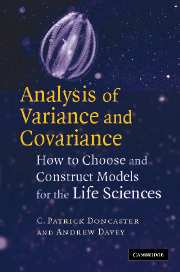Book contents
- Frontmatter
- Contents
- Preface
- Introduction to analysis of variance
- Introduction to model structures
- 1 One-factor designs
- 2 Nested designs
- 3 Fully replicated factorial designs
- 4 Randomised-block designs
- 5 Split-plot designs
- 6 Repeated-measures designs
- 7 Unreplicated designs
- Further Topics
- Choosing experimental designs
- How to request models in a statistics package
- Best practice in presentation of the design
- Troubleshooting problems during analysis
- Glossary
- References
- Index of all ANOVA models with up to three factors
- Index
- Categories of model
Introduction to analysis of variance
Published online by Cambridge University Press: 13 November 2009
- Frontmatter
- Contents
- Preface
- Introduction to analysis of variance
- Introduction to model structures
- 1 One-factor designs
- 2 Nested designs
- 3 Fully replicated factorial designs
- 4 Randomised-block designs
- 5 Split-plot designs
- 6 Repeated-measures designs
- 7 Unreplicated designs
- Further Topics
- Choosing experimental designs
- How to request models in a statistics package
- Best practice in presentation of the design
- Troubleshooting problems during analysis
- Glossary
- References
- Index of all ANOVA models with up to three factors
- Index
- Categories of model
Summary
What is analysis of variance?
Analysis of variance, often abbreviated to ANOVA, is a powerful statistic and a core technique for testing causality in biological data. Researchers use ANOVA to explain variation in the magnitude of a response variable of interest. For example, an investigator might be interested in the sources of variation in patients' blood cholesterol level, measured in mg/dL. Factors that are hypothesised to contribute to variation in the response may be categorical or continuous. A categorical factor has levels – the categories – that are each applied to a different group of sampling units. For example, sampling units of hospital patients may be classified as male or female, representing two levels of the factor ‘Gender’. By contrast, a continuous factor has a continuous scale of values and is therefore a covariate of the response. For example, age of patients may be quantified by the covariate ‘Age’. ANOVA determines the influence of these effects on the response by testing whether the response differs among levels of the factor, or displays a trend across values of the covariate. Thus, blood cholesterol level of patients may be deemed to differ among male and female patients, or to increase or decrease with age of the patient.
A factor of interest can be experimental, with sampling units that are manipulated to impose contrasting treatments. For example, patients may be given a cholesterol-lowering drug or a placebo, which represent two levels of the factor ‘Drug’.
- Type
- Chapter
- Information
- Analysis of Variance and CovarianceHow to Choose and Construct Models for the Life Sciences, pp. 1 - 41Publisher: Cambridge University PressPrint publication year: 2007
- 1
- Cited by



